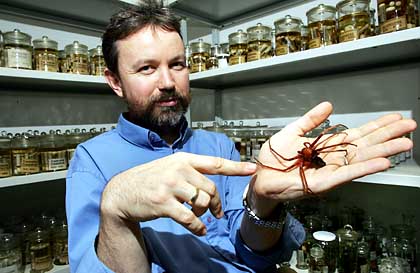
December 15, 2008
Perhaps it is only me, but it seems that some “new species” press releases these days are oriented to be a bit over-the-top to get out attention, don’t you think?

Now we have yet another new one just produced by the World Wildlife Fund, entitled “First Contact: New Species Discoveries.”
Statistically, the numbers are large. But we have to take into account that if you pick out a large enough area, say like the greater Mekong region, comprising Cambodia, Laos, Myanmar, Thailand, Vietnam and China’s Yunnan province, then detail all finds from 1997-2007, one would expect a large number of new species. Right?
The report says that more “than 1,000 species – spiders, mammals, snakes and a hot pink, poisonous millipede – have been discovered in the Greater Mekong region…, creating an urgency for environmental groups that fear widespread destruction of the land.”
In the current world of discoveries in our planet, this is very big. Now that the region has stabilized, researchers have been able to go in and document the species. Their findings show it is a major global hotspot for biodiversity, a treasure.
Pete Ewins, director, WWF Canada’s species conservation programs
But why are they confusing “discoveries” with known animals.
The release mentions that the Greater Mekong region is “home to 430 mammal species, including the Asian elephant, Irrawaddy dolphin and Javan rhino, and is one of the last strongholds for the critically endangered Indochinese tiger.” But these mammals were not discovered in the last 12 years.
The majority of new discoveries, which, of course, would include a very few mammals, is definitely more about finding small invertebrate animals.

Peter Jaeger with Heteropoda maxima at the Frankfurter Forschungsinstitut Senckenberg (07.12.05). Photo: Thomas Lohnes/ddp.
The new report documents at least 88 new species of spiders. One of the most significant finds was the Heteropoda maxima, a spider with a leg span of up to 30 cm, considered one of the largest huntsman spiders in the world.
Another new species, which we have discussed on Cryptomundo before, is the Desmoxytes purpurosea or the “dragon millipede.” Hot pink and spiny, the millipede has glands that produce cyanide for its defense. The report says that “several millipedes were found sitting and moving on limestone rocks and on the leaves of Arenga pinnata palms.”
These are all interesting, needless to say, but out of a 1000 new species, most are not large new mammals, as a quick reading of such releases would have the public believe.
I am all for acknowledging the reality of new animals, efforting conservation drives, engaging in habitat preservation, and finding new species. But I feel it undermines the critical and yet exciting nature of all of this by issuing overblown press releases that merge the lines between mammals and spiders to get the public’s support.
Later update and clarification:
The discoveries documented in the WWF report “First Contact” report for the Greater Mekong include 519 plants, 15 mammals, 89 frogs, 279 fish, 46 lizards, 22 snakes, 4 birds, 4 turtles and 2 salamanders.
Among the 15 mammals discovered in the region was the Laotian rock rat, Laonastes aenigmamus.
It was thought to have been extinct for 11 million years but a researcher spotted the corpse of one on sale in a food market in Laos in 2005.
About Loren Coleman
Loren Coleman is one of the world’s leading cryptozoologists, some say “the” leading living cryptozoologist. Certainly, he is acknowledged as the current living American researcher and writer who has most popularized cryptozoology in the late 20th and early 21st centuries.
Starting his fieldwork and investigations in 1960, after traveling and trekking extensively in pursuit of cryptozoological mysteries, Coleman began writing to share his experiences in 1969. An honorary member of Ivan T. Sanderson’s Society for the Investigation of the Unexplained in the 1970s, Coleman has been bestowed with similar honorary memberships of the North Idaho College Cryptozoology Club in 1983, and in subsequent years, that of the British Columbia Scientific Cryptozoology Club, CryptoSafari International, and other international organizations. He was also a Life Member and Benefactor of the International Society of Cryptozoology (now-defunct).
Loren Coleman’s daily blog, as a member of the Cryptomundo Team, served as an ongoing avenue of communication for the ever-growing body of cryptozoo news from 2005 through 2013. He returned as an infrequent contributor beginning Halloween week of 2015.
Coleman is the founder in 2003, and current director of the International Cryptozoology Museum in Portland, Maine.
Filed under Breaking News, Cryptotourism, CryptoZoo News, Cryptozoologists, Cryptozoology, New Species